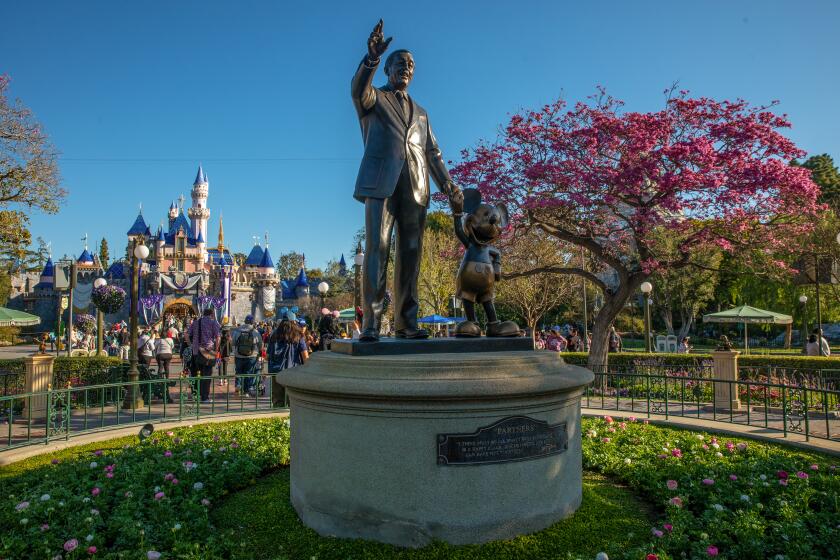A Vast Panorama From Mission Point
- Share via
Billowing grass and seasonal wildflowers paint a pastoral landscape on hillsides of Los Angeles’ second largest park. O’Melveny Park, located at the north end of the San Fernando Valley, is the principal recreation area in the Santa Susana Mountains.
A visit to O’Melveny Park on a brisk autumn day can be delightful. Views of the Southland from 2,771-foot Mission Point are often quite good. Fall wildflowers include the white trumpet-shaped jimson weed, scarlet California fuchsia and yellow goldenbush.
Abundant Wildlife
Wildlife in the park includes deer, golden eagle, bobcat, rabbit, raccoon and coyote. All this flora and fauna next to super-suburban San Fernando Valley!
This hike follows a fire road to Mission Point and explores the wild part of O’Melveny Park. Bring a city map. As you climb high into the Santa Susana Mountains, you can pick out numerous natural and man-made points of interest.
Directions to trailhead: Exit the San Diego Freeway (I-405) on Rinaldi and turn west. Turn right on Balboa Boulevard and in three-quarters of a mile turn left on Jolette. Follow Jolette a mile to Sesnon Boulevard. (A right turn on Sesnon will take you to the developed part of O’Melveny Park.) Turn left on Sesnon, then right on Neon Way. Park at the end of Neon Way. The fire road leading to Mission Point starts here.
The Hike: The fire road leads you past a seasonal brook and begins to climb high above the nearby residential area. It is moderate to strenuous climbing the first mile. Evidence of the 1971 earthquake that damaged the nearby Golden State Freeway and Van Norman Dam is present as fissures and slides. The Santa Susana mountain range is one of California’s most seismically active areas. The Santa Susanas are separated from the western end of the San Gabriel Mountains by Newhall Pass. A fault runs through the pass creating the separation.
Variety of Vegetation
As you make your ascent, you’ll notice quite a difference in vegetation between north and south slopes. The canyon’s dry north slopes are blanketed with sage and other coastal scrub. To the south, the hills are covered with grasses punctuated by an occasional live oak or California walnut. The hiker with Halloween on his mind may notice what at first appears to be puny pumpkins growing in patches alongside the trail. On closer inspection these “pumpkins” turn out to be Calabazilla, or stinking gourd. Early Spanish settlers used the large roots as both a soap and a purgative.
As you near the top, you’ll pass a small stand of big cone spruce. One might suspect that these “Christmas trees” were planted, but park rangers swear that the spruce are native. Big cone spruce grow as low as a half-mile up the mountain, so it’s quite likely the trees are native.
Close to the top, a couple of washed-out dirt roads and bulldozer lines converge. (All roads lead toward Mission Point, but the “main road” is easier walking.) Navigate toward four sturdy oaks, which offer a nice picnic or rest stop.
Just past the oaks, a dirt road branches left and leads to wind-blown Mission Point. A 1932 U.S. Geological Survey marker is atop the point. Two seasonal cow ponds are located on the southwest slope. Below Mission Point to the northwest are oil fields and natural gas underground storage areas.
Enjoy the view of the Santa Susana Mountains--including nearby Oat Mountain, highest peak in the range. The San Gabriel Mountains, Santa Monica Mountains, Santa Clarita Valley and downtown Los Angeles are also part of the 360-degree panorama. Return the way you came.
O’Melveny Park Trail
Bee Canyon to Mission Point: 4 1/2 miles roundtrip, 1,400-foot gain in elevation
MP, JOHN SNYDER / Los Angeles Times
More to Read
Sign up for The Wild
We’ll help you find the best places to hike, bike and run, as well as the perfect silent spots for meditation and yoga.
You may occasionally receive promotional content from the Los Angeles Times.






